Cats are very smart, many owners notice that the animal is listening and listening. Thoughts about training creep in by themselves, but some people mistakenly believe that cats are not amenable to her. You can start classes with your pet from 7-8 months of age. At this age, the kitten will already be able to adequately respond to the speech of the owner. The main thing is to take into account the perception of the cat.


Abilities and features of memory
Pets are distinguished by a subtle psyche and extreme emotionality. It is this feature that allows cats to become attached to family members. It is important to note that such an animal does not perceive a person as an unconditional leader. It is necessary to focus attention during training not on the suppression of the cat, but on the delivery of positive emotions to him.
Feline memory stores only the most important information. The animal will soon forget the guest who visited your house only once. Memories of the pain caused by the person will long remain. Feline memory is good, but extremely selective. The animal is able to remember forever where the tray is, with what sound the refrigerator with food opens, how the packaging of delicious food rustles. Such things are of great importance to the cat, which means they simply cannot be forgotten.
All smells, sounds and events that are of no use will be forgotten in the near future.


During training, you need to consolidate the memories of the teams with something important. To do this, you can use praise, affection, sweets and other positive things. Scientific experiments have proven that short-term memory in cats contains information for the last 12-16 hours. For comparison, dogs retain only the last 5 minutes, or even less. Long-term memory in cats is even more developed, so they can be trained no worse than other animals.
The cat is most susceptible at the age of 2-7 weeks. It is during this period that the kitten is taught to people, toilets, bowls with food and similar things. In the future, contact with something new can be painful for the animal. Of course, an adult cat can also get used to people and the toilet, but it will take more time. Therefore, it is better to start training at an early age.

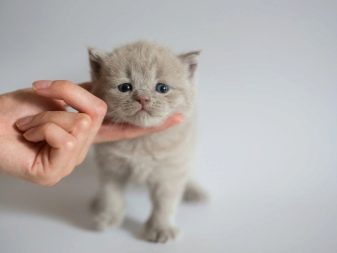
Felinologists proved that memory, sensitivity and decision-making skills develop and form in cats up to two or three years. A young animal studies with curiosity and assimilates information during observation. By this principle, you can teach a cat to go to the toilet on the toilet. It is enough to demonstrate this procedure several times.
Adult cats can solve logic puzzles. In favor of this fact are the jumping of animals, which are always verified, and allow you to clearly overcome the required distance. This is easy at first glance, in fact, for the action you need to analyze the distance, select the desired trajectory and calculate the force. Kittens learn such jumps as a child, this skill is not born.
Throughout life, cats, like humans, worsen memory. After 7-8 years, the animal not only worse remembers something new, but also with great difficulty copes with information that is already in memory.
Attempts to train at this age will not bring results. Moreover, the mass of negativity is provided to both the pet and the owner.
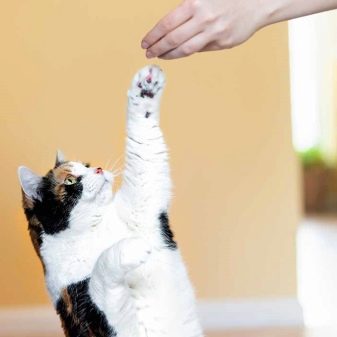
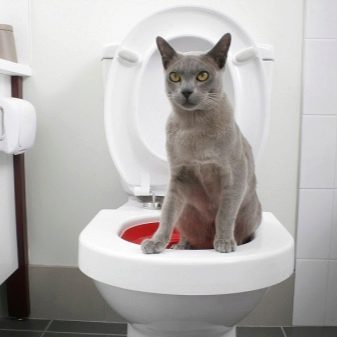
Many people notice that cats perfectly perceive speech and remember words. Pets remember important phrases of the owner, followed by something pleasant or significant. And also animals understand when they are scolded. Two weeks are enough for the cat to begin to understand speech even in another language. The words of all family members, both children and adults, are equally perceived. This feature is due to the fact that the pet does not react to the words themselves, but to the emotional message, the energy of the phrase. In other words, The feline brain analyzes the size and length of the sound wave.
So cats memorize commands, and do it faster than dogs. The latter require about 7 repetitions, and cats only 3. If certain rules are followed, it will be easier to train a cat than the most intelligent and quick-witted dog.

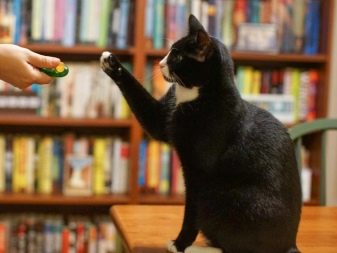
Are all breeds amenable to training?
Kitten teaches mom from the first day of life. Moreover, even then you can notice that some animals quickly grasp a new experience, others modernize it, and others hesitate for a long time before making a decision. It will be easy to train a cat if he is active, curious and contact by himself. But there are breeds that are easiest to train.
- Abyssinian cat has a playful disposition. She quickly delves into the rules of the master's house. Animals love to interact with people. It will be easy to train in a playful way.
- Cornish Rex - a small, curly and curious beast. Training, training and physical activity will benefit. The animal loves to follow the owner in the wake, the poem takes any communication positively.
- Burmese needs constant attention and affection. A cat of this breed is active, perfectly amenable to training. Animals enjoy demonstrating their skills to people.
- Scottish lop-eared from birth knows how to stand on its hind legs. The breed is distinguished by intelligence, activity and quick wit. Mostly cats like to learn tricks, not just teams.
- British Shorthair similar in nature to the previous breed. A moving, talkative and very sociable cat loves praise and increased attention to her person.
- Thai The breed loves attention and physical affection. Always distinguishes the most beloved owner from the family and is ready to obey him in everything.Cats remain active and curious even in adulthood. A great example of the fact that you can train not only kittens.
- Bengal cat literally needs upbringing. Otherwise, activity and playfulness turns into prudence. They are able to imitate the owners. By our own example, you can teach a cat to turn off the light, open a door or tap with water.
- Singapore breed different curiosity. Cats are always on the move, they love to jump, run and overcome obstacles. The pet is always open to new, therefore, willingly learns tricks and teams.
- Turkish van - a rare and ancient breed. Such cats love to swim and play with toys. They are distinguished by great affection for the owner and are always ready to show their love. He likes to jump on people, sit on his hands. They convey their mood with voice and movements. High sociability makes the breed as suitable for training as possible.
If your pet is a representative of a more phlegmatic breed, do not rush to be upset. Many Persian cats love to learn commands and perform various tricks.
The effectiveness of training directly depends on your tolerance and the right approach to the animal.






rules
Choose the right moment to start training. The animal should be in a good mood, after eating it is worth waiting at least 2 hours. Training at home will be successful, if you keep in mind the important nuances.
- Be patient. Do not try to learn several teams at once in a short time. Start training from 5 minutes every 2-3 days. If the cat is sluggish, stop training.
- The family member whom the cat perceives as the owner should be engaged in training. Do not offend the animal so as not to lose confidence. Otherwise, the cat will cease to obey, in general.
- Encourage in small pieces of soft, tasty, aromatic food.
- Choose the right tone of voice. Behave as calmly as possible, without a trace of aggression.
- Do not scold or punish failure. Remember that cats are not used to obeying, they can only be friends.
If the cat or cat shows indifference or tiredness, stop training immediately. Do not show your strength and power, this approach will provide a loss.
Do not force to perform actions that the pet does not like.



What is necessary?
Be patient so as not to cause discomfort in the animal with your excessive pressure. It is important that the cat trust you. Training should be done only by that person from a family whom the pet is ready to obey. If the animal is offended and ceases to trust, then training will have to be postponed for a long period. Prepare a treat for the animal. Use something small and tasty. You can use pieces of meat, cheese, liver. The cat should only get angry, but not to eat too much. Dry food is not suitable, a pet can only eat soft food quickly.
Give treats with your hands, do not throw on the floor. So the cat will be able to trace the connection between your actions and calculate the pattern. Give commands in an even voice. Intonation should be the same every time.
If necessary, introduce the necessary equipment for tricks in advance.


Teams and Tricks
You need to deal with a kitten 5-10 minutes a day for a successful result. If you decide to teach an adult cat, then repeat the training after 2-3 days, and carefully monitor her mood. There are several teams for beginners.
- "To me". Call the cat by the nickname, having prepared a treat. When the cat is close, say the command. In the end, be sure to caress and treat the animal. In one lesson, repeat the command 3-5 times. 5-6 trainings are enough for a cat to run on command without additional incentive in the form of a tasty treat.
- "Bring". In the process of training, use your favorite cat toy.During the game, drop the thing and say the command. Show a treat in your outstretched hand. If the cat comes to you without a toy, hide the treat and repeat the request. Give a treat only when the cat brings the right thing.
- “Ask”. The goal is for the animal to stand on its hind legs and ask for goodies. First, call the cat to a flat vertical surface so that there is something to lean on. Raise your hand with a treat high and say a command. Give the treat as soon as the cat stands on its hind legs. Increase the height of your hand gradually if necessary.
- "Nearby". The team is very similar to Come To Me. Walk with the cat around the room or at home, periodically tell her to be near. Call and repeat the command, give refreshments.
- "Sit". Learning a team is not subject to all cats. The treat alone will not help, you need to lightly press near the tail, as if seating the animal. To get started, go to the cat and lower to its level. Show yummy in your open hand. Invite the cat to sit next to it, pat it on the floor or furniture. Say the command at the same time. As soon as the animal sits down, caress and give refreshments.
- "Lie down." A skill that comes in handy especially when visiting a doctor. Approach the cat when she will sit. Show the animal a treat, and lower your open hand to the floor, as if hinting that you need to go down. Say a command and help the cat lie down. If the animal itself does not understand what is required of it, then it is necessary to gently bend the front legs. Once the command is complete, give a treat.
- "Stop". Begin training while the cat is walking straight towards you. Stop the animal with your hand, as if placing a barrier. Say a command and wait for a full stop. Give a piece of food immediately. If the cat ignores the barrier, then continue trying. It is important to make it clear that there will be no goodies without stopping. After a few workouts, say the command, but do not obstruct the movement.

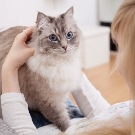


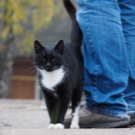

Teaching teams is relatively quick and easy. It’s much more interesting to train a cat in interesting tricks. Consider the step-by-step training of the Give a Paw trick.
- First, tell the cat to sit. For successful training, this team must already be unlearned.
- Say the command "Give a paw", and do the action yourself, instead of the cat. So the animal will understand how to satisfy the request.
- Give me a treat.
- Continue training until the cat remembers exactly what action she needs to perform.


To teach a cat to jump over an obstacle is quite simple. To get started, pick up a low barrier and put a treat behind it. Point the cat to the obstacle and do not give the treat until it jumps. You can show by your own example that the barrier needs to be overcome, for example, step over it.
Jumping through a hoop can be taught quite simply.
- Call the cat, show the hoop. Put a ring between you and your pet.
- Through the hoop, show the treat and say the command “Up”.
- If the cat is trying to get around the item, then move it synchronously. Give treats when the animal jumps through the ring.

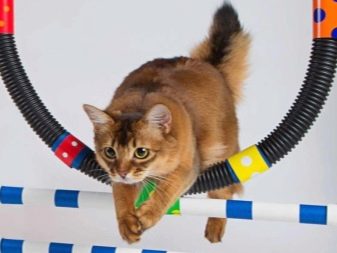
Cats that stand on their hind legs look quite interesting, and this can also be taught. Call your pet and raise your hand with a treat higher. Say the “Stand” command, and give yummy as soon as the pet fulfills the request.
In order for the cat to stand on its hind legs for a long time, offer it a few pieces of food. Complicate the training with the “Spin” command and the corresponding circular motion of the hand.
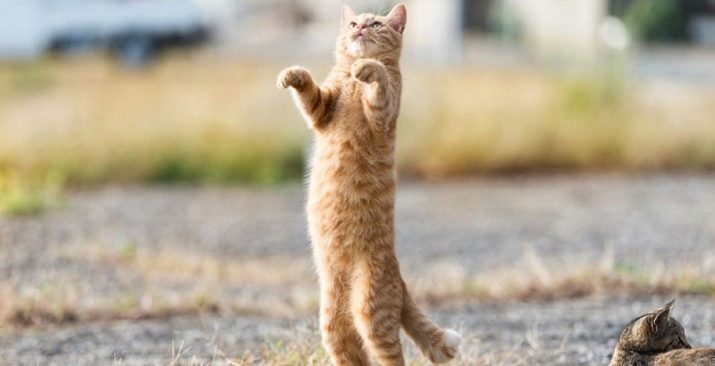
The most difficult trick is the “Die” team. It will take a lot of time to learn, and perhaps the active pet simply will not be able to lie still, be prepared for this. Conduct training in stages.
- During games, lightly push the cat and say the command "Die." As a result, the animal must lie down or fall.
- Hold with your hand, as if not letting you stand.
- Release and speak the command “Revive”.
- Give me a treat.

See how to teach a cat how to give a paw in the next video.


































